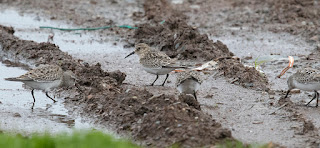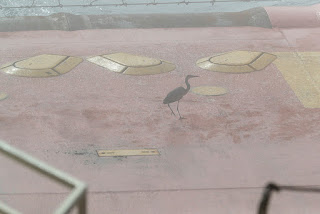Pink-footed Goose lost its mega rarity status in North America around the turn of the century. A small and ever so slowly growing number are now expected during the winter in the New England States. It is seen regularly in autumn migration in Quebec and somewhat so in Nova Scotia and New Brunswick. This is a long way from the first North American Pink-footed Goose for North America in May 1980 at St. Anthony. I saw that bird. Paul Linegar saw that bird. Norm Chesterfield, the first person to see 500 species in Canada came to see that bird. When news of two Pink-footed Geese spotted by Carol McDougall at Branscombe Pond in St John's came over the rare bird line at 11 am today I thought to myself - "Great, it will be nice to see two together and with other geese". There was no exploding out the office door and speeding through traffic to see the bird soon as possible. I could wait until lunch hour to drive the ten minutes from work with other rules-of-the-road law abiding citizens. Most birders in St. John's were over saturated with images of Pink-footed Goose after one spent December to April with the tame ducks at Bowring Park a few years back.
The light was fantastic on the flock of 18 Canada and 2 Pink-footed Geese. Low mid-day October sun light is a beautiful thing. The birds were just a little bit far for cameras. Even the 840 mm was not really enough but a little cropping made the photos more revealing. Here are some of the pics.
It remains to be known whether we will see these two Pink-footed Geese again. This has been a game changing fall for Canada Geese in St. John's. Up until this year only the occasional one or two or three Canada Geese would enter St. John's and maybe feed on the grass in a fenced off ball field or Bally Haley golf course. This fall there has been a couple of flocks of 20-30 geese. One flock frequenting Virginia Lake and feeding on the pond weed. Another flock of about 20 geese has been sporadically seen at Mundy Pond and perhaps the same flock seen feeding in at field off Brookfield Road. It might be this flock that the the Pink-footed Geese joined. There are now harvested cornfields in the Goulds that would be excellent forage for geese. And last time I checked Bally Haley there were five Canada Geese there.
We need these Canada Geese as decoys to lure in wandering rare Greenland geese such as these two Pink-footed Geese. It should be noted that the Virginia Lake goose flock includes an interesting hybrid goose that I like to support the thinking is a Canada Goose x Greater White-fronted Goose. Below are some pictures of this interesting goose.

































